Upgrading your Kawasaki Ninja 400’s exhaust system can greatly transform your riding experience, not just regarding performance but also sound quality. You might be surprised to learn that the right exhaust can enhance throttle response and reduce weight, making your bike feel more agile. With several options available, each boasting unique benefits, you’ll want to evaluate what best aligns with your needs. So, which exhaust systems stand out as the top choices for both performance and that unmistakable roar? Let’s explore the six best options that can take your ride to another level.
Key Takeaways
- Upgrading to a performance exhaust system can significantly boost horsepower, torque, and overall engine efficiency for the Kawasaki Ninja 400.
- Lightweight materials, like aluminum and carbon fiber, enhance agility and improve the power-to-weight ratio for better acceleration.
- Slip-on exhaust systems offer easy installation in 10-15 minutes, making upgrades accessible for most riders without extensive modifications.
- High-quality exhaust systems improve sound quality, providing a richer tone without excessive drone, enhancing the overall riding experience.
M4 Performance Exhaust X96 Carbon Canister Slip-On for Kawasaki Ninja 400 (2018-2023)
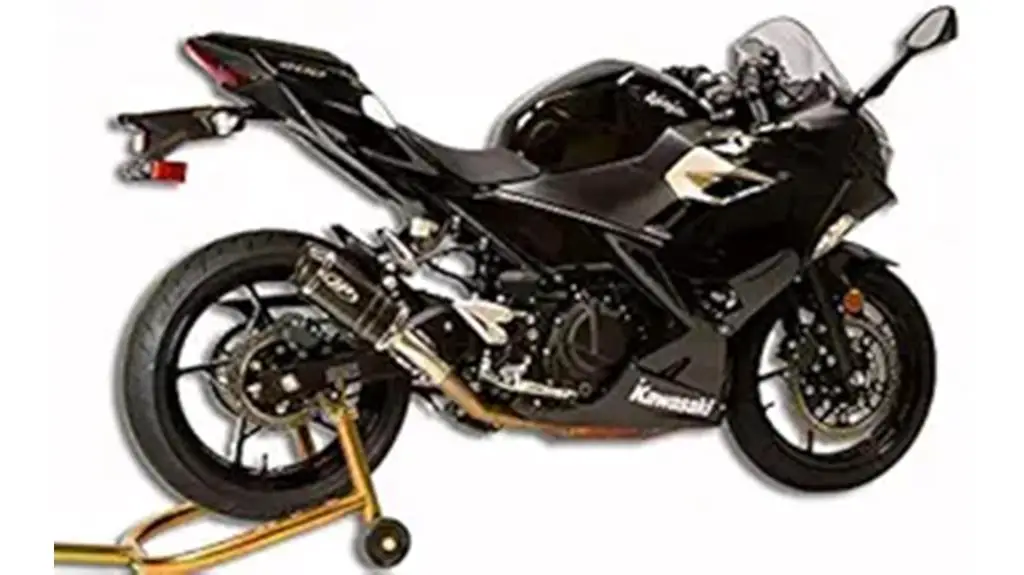
Offering enhanced performance and a sleek look, the M4 Performance Exhaust X96 Carbon Canister Slip-On is an ideal upgrade for Kawasaki Ninja 400 owners seeking to elevate their riding experience from 2018 to 2023.
This slip-on exhaust system is designed specifically for the Ninja 400, Z400, EX400, and EX400ABS, ensuring a perfect fit.
Weighing just 6 pounds, it’s lightweight yet robust, contributing to better overall performance.
The carbon canister not only improves the bike’s sound but also adds a touch of style.
Available since February 6, 2023, it comes with a 30-day return guarantee, allowing users to purchase with confidence.
With the M4 exhaust, riders can enjoy a noticeable boost in power and an exhilarating auditory experience.
Best For: Riders of the 2018-2023 Kawasaki Ninja 400, Z400, EX400, and EX400ABS looking to enhance performance and aesthetics.
Pros:
- Lightweight design at only 6 pounds, contributing to overall bike performance.
- Sleek carbon canister adds a stylish look while enhancing the sound of the exhaust.
Cons:
- Installation may require tools and mechanical knowledge, which could be a barrier for some users.
- Price may be higher compared to stock exhaust options, affecting budget-conscious buyers.
WATERWICH Motorcycle Muffler for Kawasaki Ninja 400
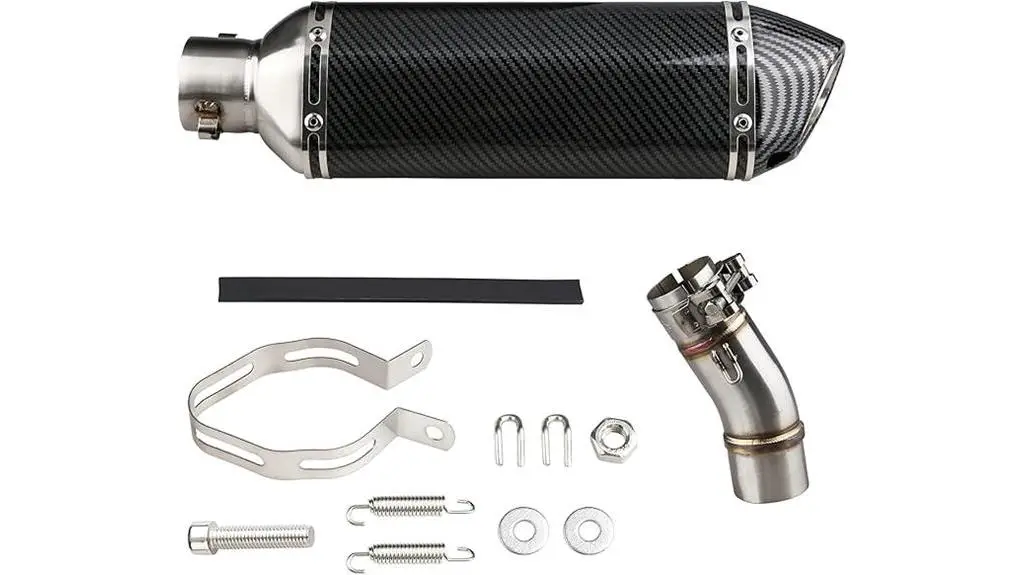
The WATERWICH Motorcycle Muffler offers Kawasaki Ninja 400 owners a lightweight and easy-to-install option that enhances performance while delivering a premium sound quality.
With a slip-on design, this muffler can be installed in just 10-15 minutes without the need for welding. Constructed from quality aluminum and stainless steel, it reduces overall weight, allowing for maximum output.
The muffler features high temperature and pressure resistance, while internal partitions minimize distortion. Riders can also adjust sound levels with the removable DB killer, achieving a factory-style sound.
Although it boasts an average rating of 3.9 stars, some users have reported missing assembly instructions.
Overall, WATERWICH provides a solid choice for those looking to upgrade their Ninja 400’s exhaust system.
Best For: Riders looking to enhance the performance and sound quality of their Kawasaki Ninja 400 without extensive installation time or effort.
Pros:
- Easy slip-on installation takes only 10-15 minutes with no welding required.
- Lightweight design constructed from quality aluminum and stainless steel improves overall performance.
Cons:
- Average customer rating of 3.9 out of 5 stars indicates mixed feedback.
- Some users have reported missing assembly instructions, which can complicate installation.
Vizi-tecs exhaust Servo buddy (Friend) replacement for Kawasaki.
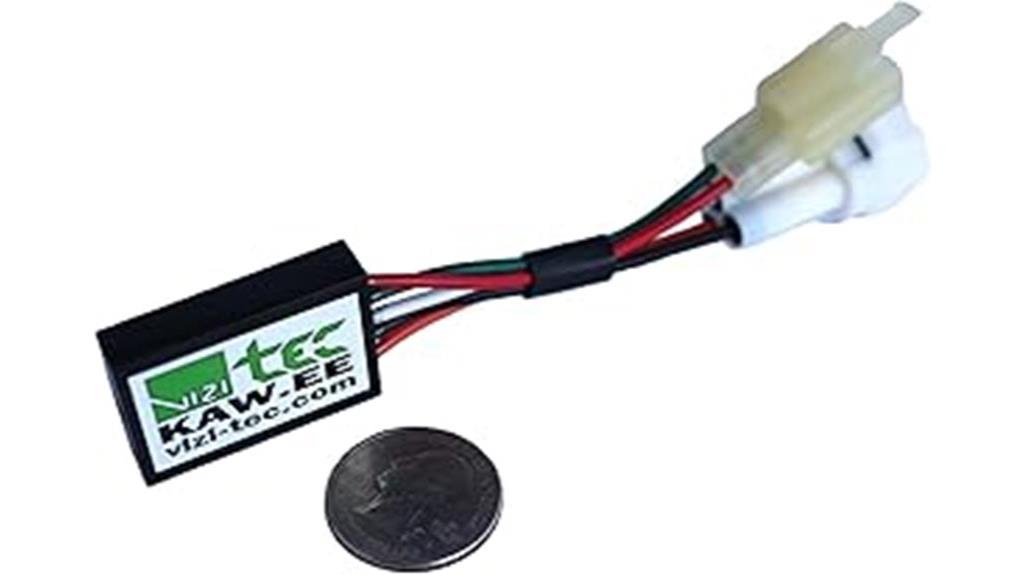
For Kawasaki Ninja 400 owners seeking a reliable solution to eliminate check engine lights, the Vizi-tecs Exhaust Servo Buddy offers a simple plug-and-play installation that enhances performance without the hassle.
This solid-state device is designed for various Kawasaki models, including the Ninja series, ensuring compatibility with a wide range of bikes.
Weighing only 2 oz and measuring compactly at 1.4 x 1.0 x 0.3 inches, it’s easy to install and doesn’t take up much space.
Users appreciate its durability, thanks to marine-grade epoxy encapsulation that protects against dirt and moisture.
With a lifetime warranty and high customer ratings, the Vizi-tecs Servo Buddy stands out as a dependable choice for resolving check engine light issues efficiently.
Best For: Kawasaki Ninja 400 owners who want an efficient and easy solution to eliminate check engine lights.
Pros:
- Easy plug-and-play installation saves time and effort.
- Durable construction with marine-grade epoxy protects against environmental damage.
Cons:
- Not suitable for resolving error codes that can’t be cleared with stock hardware.
- Limited to specific Kawasaki models, requiring confirmation of compatibility.
Caltric Muffler Pipe Gasket for Kawasaki ZX-6R Ninja (1998-2016)
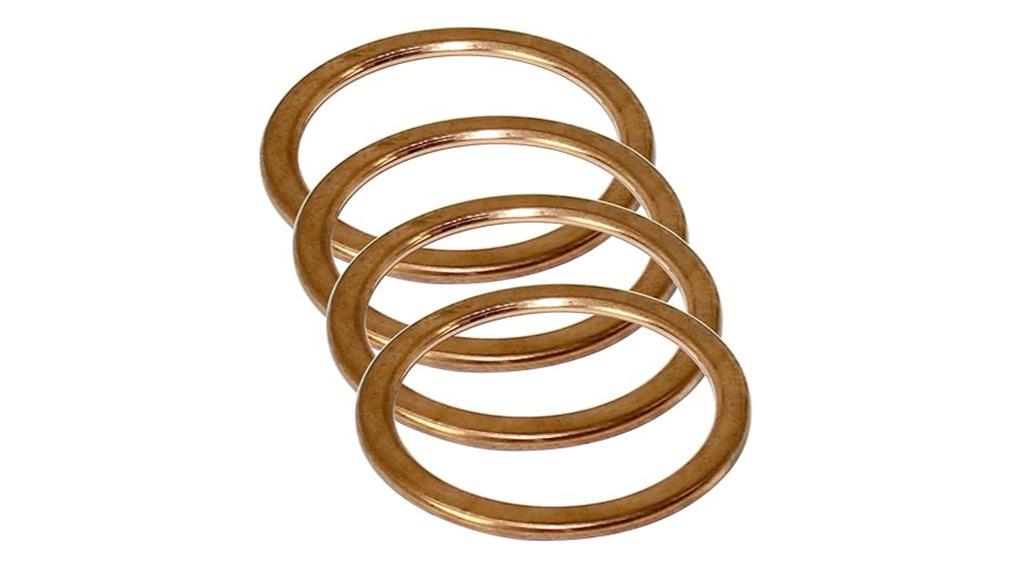
Designed specifically for Kawasaki ZX-6R Ninja models from 1998 to 2016, the Caltric Muffler Pipe Gasket provides a reliable solution for eliminating exhaust leaks and improving engine performance.
Each order includes four gaskets, ensuring users have enough for a complete installation. Users have reported that installing this gasket resolves annoying ticking noises and effectively eliminates exhaust leaks.
Customer feedback highlights the gasket’s great fit and Caltric’s A++ service, with fast shipping being a consistent point of praise. It’s also compatible with various other Kawasaki models, making it a versatile choice for riders.
For best results, users are encouraged to compare the posted picture to their current unit before purchasing.
Visit Caltric’s Amazon store for a broader range of aftermarket parts.
Best For: Riders of Kawasaki ZX-6R Ninja models (1998-2016) and other compatible Kawasaki models seeking to eliminate exhaust leaks and improve engine performance.
Pros:
- Fast and reliable service with A++ customer ratings.
- Great fit ensures effective sealing and optimal performance.
Cons:
- May not be compatible with non-Kawasaki models.
- Installation requires basic mechanical skills and tools.
MBRP S5200AL 3 Cat Back, Single Side Exhaust System (Aluminized Steel)
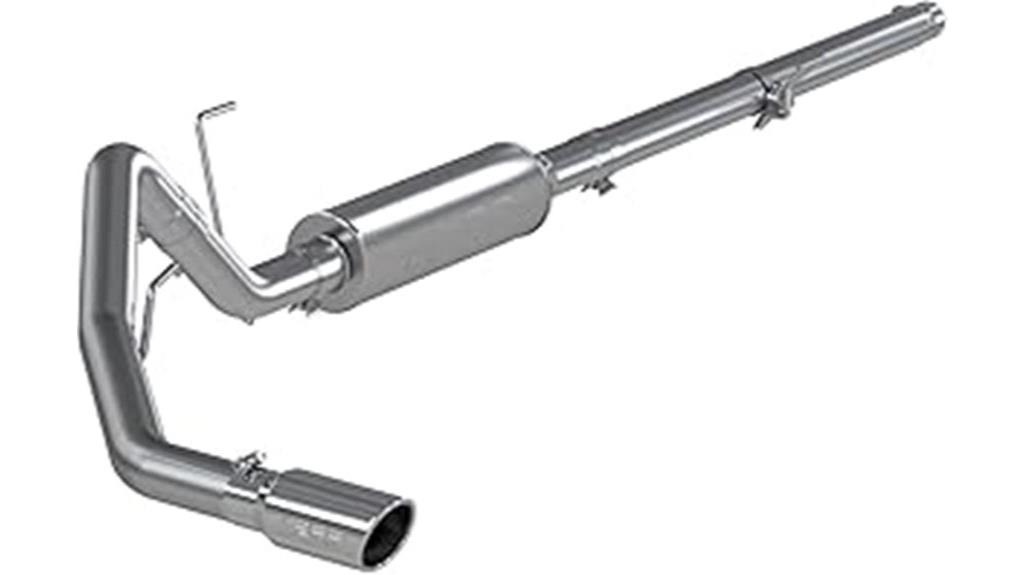
For riders seeking a robust performance upgrade, the MBRP S5200AL 3 Cat Back exhaust system delivers a rich, mellow exhaust note while enhancing torque and horsepower.
Constructed from heavy-duty aluminized steel, this system features a mirror-polished T304 stainless steel tip, ensuring durability and aesthetic appeal.
Installation is straightforward, requiring only common hand tools, and typically takes just 1-2 hours.
Riders appreciate the sound quality, noting a mean tone at low RPMs with a satisfying rumble that avoids excessive drone.
This system can improve fuel economy by 1-2 mpg and helps maintain cooler engine operation by efficiently expelling hot exhaust gases.
Backed by a 3-year warranty, MBRP also offers reliable customer support for any inquiries.
Best For: Enthusiasts looking for a performance exhaust upgrade that enhances sound and power without excessive drone.
Pros:
- Improves fuel economy by 1-2 mpg, making it a more efficient option.
- Easy installation with a bolt-on design and all necessary parts included.
Cons:
- Some users report mismatched hangers or missing parts during installation.
- Cutting of the mid-pipe may be required for proper fit, which could complicate the installation for some.
Dynomax Super Turbo 39510 Exhaust System Kit for Jeep Wrangler
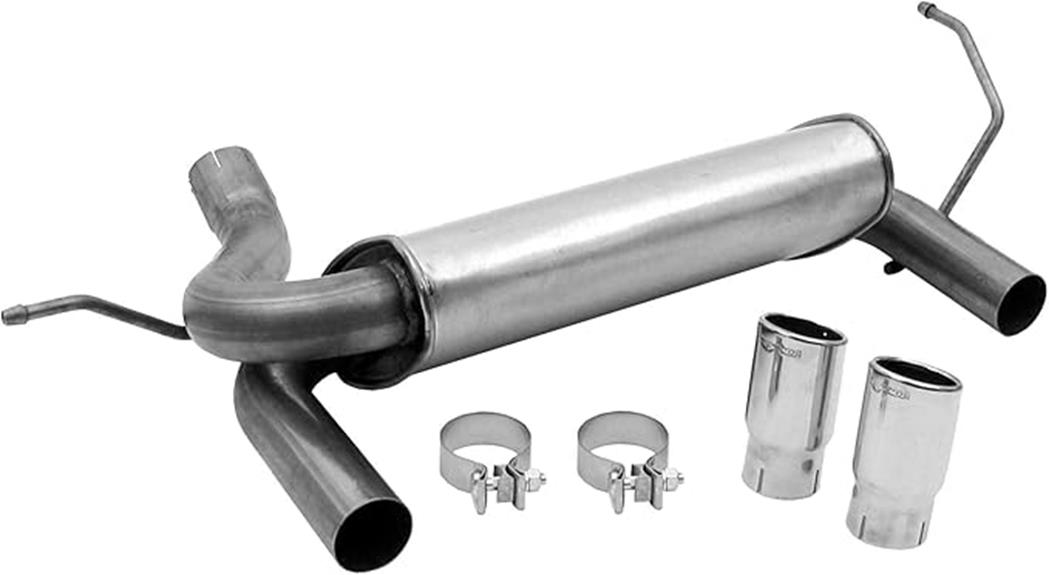
Designed specifically for Jeep Wrangler models from 2007 to 2018, the Dynomax Super Turbo 39510 Exhaust System Kit markedly enhances performance with a notable boost of 14 horsepower and 12 lb-ft of torque.
This complete exhaust solution includes a DynoMax Super Turbo muffler, 3-inch stainless-steel tips, and necessary clamps, ensuring an easy installation with welded hangers and mandrel-bent tubing.
Its durable stainless steel construction not only enhances flow capacity but also delivers a mellow exhaust tone while reducing turbulence.
Customers appreciate the straightforward installation process and the satisfying sound quality, although some have noted alignment issues.
Overall, this exhaust system stands out as an effective upgrade for Jeep Wrangler enthusiasts looking to improve their vehicle’s performance and sound.
Best For: Jeep Wrangler owners (2007-2018) seeking a performance upgrade with improved sound and ease of installation.
Pros:
- High performance boost with 14HP and 12 lb-ft torque improvement.
- Easy installation due to welded hangers and included clamps.
Cons:
- Potential alignment issues during installation reported by some users.
- Sound levels may not suit all preferences, as some may find it too loud or not loud enough.
Factors to Consider When Choosing Exhaust Systems for Kawasaki Ninja 400
When you’re choosing an exhaust system for your Kawasaki Ninja 400, several key factors come into play.
Reflect on how much you want to enhance performance, reduce weight, and the complexity of installation.
Don’t forget to take into account sound quality and material durability, as these will greatly affect your riding experience.
Performance Enhancement
Choosing the right exhaust system for your Kawasaki Ninja 400 can dramatically boost its horsepower and torque, making every ride more thrilling. When you upgrade to a performance exhaust, you’ll notice a more responsive throttle and improved acceleration, which enhances your overall riding experience.
Look for exhausts that improve exhaust flow, as this can lead to cooler engine operation and better fuel efficiency—potentially giving you an extra 1-2 miles per gallon. It’s also important to take into account the materials used in the exhaust. High-temperature and pressure-resistant options help minimize distortion, ensuring consistent performance over time.
Another factor to take into account is sound customization. Some aftermarket systems come with removable DB killers, allowing you to adjust sound levels to match your preferences while maintaining performance benefits.
Keep in mind that while performance upgrades focus on power and sound, they also contribute to the overall dynamics of your Ninja 400. By choosing a well-designed exhaust, you’re not just enhancing your bike’s performance; you’re also elevating your riding experience to a whole new level.
Weight Reduction
Upgrading to a lighter exhaust system not only enhances your Kawasaki Ninja 400’s performance but also considerably improves its power-to-weight ratio, making your rides more exhilarating and agile. By reducing the weight of your exhaust, you can experience significant improvements in acceleration and handling. A lighter bike requires less effort to move, allowing you to navigate corners and straightaways with greater ease.
When choosing an exhaust system, consider lightweight materials like aluminum and carbon fiber. These options decrease overall weight without compromising strength or durability. Many aftermarket exhaust systems designed specifically for the Ninja 400 prioritize weight savings while ensuring maximal exhaust flow and sound quality.
Additionally, a reduction in weight can lead to better fuel efficiency. With less mass to propel, your engine doesn’t have to work as hard, which means you’ll enjoy longer rides between fill-ups.
Installation Complexity
Understanding installation complexity is vital, as it can greatly impact your experience with the exhaust system for your Kawasaki Ninja 400. Different exhaust systems come with varying installation requirements.
Slip-on systems, for instance, often allow for a quick 10-15 minute installation using just a few basic tools. These systems typically employ clamps and springs, making them user-friendly for DIY enthusiasts.
However, some aftermarket options may require welding or significant modifications, which can complicate the process. It’s important to take into account whether the system is designed as a direct replacement for existing components or if adjustments will be necessary. Always check compatibility with your bike’s mounting points and hardware to avoid surprises.
Additionally, pay attention to the installation guides provided. While some systems include thorough directions, others may lack clarity, leading to frustration during installation.
User feedback often emphasizes the importance of having all necessary parts included, as missing hardware can cause delays or complications. By carefully evaluating these factors, you can choose an exhaust system that fits your skill level and guarantees a smooth installation process.
Sound Quality
When selecting an exhaust system for your Kawasaki Ninja 400, sound quality plays a significant role in enhancing your overall riding experience. You’ll find various options that produce a premium factory-style sound, which can elevate your motorcycle’s appeal.
Many aftermarket mufflers come with removable DB killers, allowing you to adjust sound levels according to your preference. This versatility means you can enjoy a milder tone for casual rides or release a deep, throaty growl when you crave performance.
The internal design of mufflers is equally important, as features like partitions and specific materials minimize distortion while optimizing sound resonance. This design guarantees you get a richer tone without excessive drone, something many riders prioritize.
User feedback consistently highlights the desire for an exhaust that complements the Ninja 400’s performance aesthetics, making the right choice even more critical.
Lastly, consider the installation ease. Certain systems offer noticeable sound improvements while guaranteeing a straightforward installation process. This way, you can enhance your bike’s sound without compromising quality or dealing with complicated setups.
Choose wisely, and you’ll transform your riding experience.
Material Durability
Choosing the right material for your Kawasaki Ninja 400‘s exhaust system is essential for ensuring long-lasting durability and performance.
When selecting an exhaust, consider the material’s resistance to corrosion and high temperatures. Stainless steel is often the top choice because it offers superior durability compared to aluminum. It’s designed to withstand extreme conditions, making it a reliable option for riders who frequently encounter harsh environments.
Aluminized steel provides a cost-effective alternative, balancing weight and price, but it may not hold up as well under tough conditions. If you’re looking for the best longevity, stainless steel is the way to go.
Additionally, high-quality exhaust materials can handle operating temperatures from -45°C to +80°C, ensuring reliable performance in various weather. The construction quality also matters; options that incorporate marine-grade epoxy or solid-state designs can greatly improve durability and weatherproofing.
Ultimately, investing in a robust exhaust material won’t only enhance your bike’s performance but also save you money in the long run by reducing the need for replacements.
Compatibility With Models
Verifying your chosen exhaust system is compatible with the Kawasaki Ninja 400‘s model years from 2018 to 2023 is crucial to avoid any fitment issues. Many aftermarket exhaust options can fit multiple Kawasaki models, but you should always confirm compatibility specifically with the Ninja 400. Check the manufacturer’s part numbers and descriptions, as these often indicate which models the exhaust system is designed for.
Opting for a slip-on exhaust can simplify your installation process, as these designs typically require no welding or major modifications. This means you can enjoy enhanced performance and sound without the hassle. Before making a purchase, take the time to read user reviews and installation feedback from fellow Ninja 400 owners. Their insights can guide you in choosing an exhaust system that not only fits well but also performs admirably.
Don’t overlook the importance of compatibility, as selecting an exhaust system that doesn’t match your bike’s specifications can lead to unwanted issues down the line. By focusing on these factors, you can verify a smooth installation and maximize your Ninja 400’s performance and sound.
Maintenance Requirements
Regular maintenance of your exhaust system is vital for keeping your Kawasaki Ninja 400 performing at its best.
Start by regularly inspecting your exhaust for signs of wear, corrosion, or leaks. Catching these issues early can prevent significant performance drops and enhance safety.
Ensure your exhaust is properly installed to prevent leaks that can lead to decreased efficiency and potential engine damage.
Periodically cleaning the exhaust system helps remove carbon buildup and debris, ensuring ideal airflow and performance.
Don’t forget to check and replace gaskets as needed. A tight seal between components is essential for preventing exhaust leaks.
Also, keep an ear out for unusual noise levels or performance changes; these can be indicators of underlying issues that require immediate attention.
Price Considerations
When selecting an exhaust system for your Kawasaki Ninja 400, it’s vital to take into account the wide range of prices, which can span from budget-friendly options to high-performance models that greatly influence your overall investment. You might find basic systems for around $100, while premium options can exceed $700.
Don’t forget to factor in installation costs, as hiring a professional may add another $100 to $300 to your total. Features like removable DB killers can also affect pricing; more complex designs and higher-quality materials usually come at a premium.
Warranty considerations are important as well—systems with longer warranties or lifetime guarantees may cost more upfront but can provide better long-term value.
To maximize your investment, compare prices across different retailers and keep an eye on shipping costs, which can vary considerably. By carefully considering these factors, you can find the right exhaust system that balances quality, performance, and your budget for your Kawasaki Ninja 400.
A well-chosen exhaust system won’t only enhance your bike’s performance but also give you a satisfying sound that complements your riding experience.
Frequently Asked Questions
Will an Aftermarket Exhaust Void My Kawasaki Ninja 400 Warranty?
Yes, installing an aftermarket exhaust can potentially void your Kawasaki Ninja 400 warranty.
Manufacturers often state that modifications may lead to warranty denial if the issue arises from the aftermarket part.
However, if you can prove that the exhaust didn’t cause the problem, you might still be covered.
It’s wise to check your warranty terms and consult your dealer before making any modifications to avoid unexpected costs down the line.
How Much Horsepower Can I Expect From a New Exhaust System?
Imagine your bike’s engine as a singer belting out a powerful solo.
When you upgrade the exhaust system, you’re giving that singer a better microphone.
Typically, you can expect a gain of around 2 to 5 horsepower, but it really depends on the system you choose.
Just like a good mic boosts vocal clarity, a quality exhaust enhances your bike’s performance, letting it roar with more power and presence on the road.
Are There Sound Regulations for Aftermarket Exhausts on Motorcycles?
Yes, there are sound regulations for aftermarket exhausts on motorcycles.
These laws vary by state and country, so you need to check local regulations to confirm compliance.
Many places have specific decibel limits that you must stay within.
If you modify your exhaust, it’s important to choose an option that not only enhances performance but also adheres to these noise restrictions.
Ignoring these regulations could lead to fines or issues during inspections.
Do I Need to Remap My ECU After Installing an Exhaust?
When you install a new exhaust, you might need to remap your ECU to optimize performance.
An aftermarket exhaust can change airflow and fuel mixture, potentially affecting how your bike runs.
By remapping, you guarantee your engine gets the right fuel and air ratios, maximizing power and efficiency.
It’s usually a good idea to consult with a professional or refer to your exhaust manufacturer’s recommendations for the best results.
How Often Should I Check or Replace My Exhaust System?
Imagine cruising down the highway, the roar of your bike’s engine harmonizing with the wind.
To keep that sound and performance sharp, you should check your exhaust system regularly. Inspect it every few months for cracks, rust, or damage.
If you notice any issues, it’s best to replace it sooner rather than later. Generally, you should consider replacing it every 2-3 years to maintain peak performance and safety.
Conclusion
Upgrading your Kawasaki Ninja 400‘s exhaust system is like giving it a fresh pair of wings.
With options like the M4 Performance Exhaust and WATERWICH Muffler, you’ll not only boost performance but also enjoy a more exhilarating ride.
Remember, the right exhaust isn’t just about sound; it’s about releasing your bike’s true potential.
So, choose wisely, and let your Ninja roar down the road like a beast ready to conquer the asphalt jungle!